Ibrahim Yusuf, Nafiu Hussaini
Department of Mathematical Sciences, Faculty of Science, Bayero University, Kano, Nigeria
Correspondence to: Ibrahim Yusuf, Department of Mathematical Sciences, Faculty of Science, Bayero University, Kano, Nigeria.
| Email: |  |
Copyright © 2012 Scientific & Academic Publishing. All Rights Reserved.
Abstract
This paper deals with the stochastic modeling of system comprising two subsystems A and B in series. Subsystem A consists three active parallel units. Failure time and repair time are assumed exponential. We developed explicit expressions for mean time to system failure (MTSF), system availability, busy period and profit function using Kolmogorov’s forward equations method and perform graphical analysis to see the behavior of failure rates and repair rates on measures of system effectiveness such MTSF, system availability and profit function.
Keywords:
MTSF, System Availability, Profit Function, Active Parallel
Cite this paper: Ibrahim Yusuf, Nafiu Hussaini, Stochastic Modeling of Repairable Redundant System Comprising One Big Unit and Three Small Dissimilar Units, American Journal of Computational and Applied Mathematics, Vol. 2 No. 4, 2012, pp. 174-188. doi: 10.5923/j.ajcam.20120204.06.
1. Introduction
Stochastic models of redundant systems as well as methods of evaluating system reliability indices such as mean time to system failure (MTSF), system availability, busy period of repairman, profit analysis, etc have been researched in order to improve the system effectiveness.There are systems of three units in which two units are sufficient to perform the entire function of the system. Such systems are called 2-out-of-3 redundant systems. These systems have wide application in the real world. The communication system with three transmitters can be sited as a good example of 2-out-of-3 redundant system. Many research results have been reported on reliability of 2-out-of-3 redundant systems. For example, Chander and Bhardwaj[1], analyzed reliability models for 2-out-of-3 redundant system subject to conditional arrival time of the server. Chander and Bhardwaj[2] present reliability and economic analysis of 2-out-of-3 redundant system with priority to repair. Bhardwaj and Malik[3] studied MTSF and cost effectiveness of 2-out-of-3 cold standby system with probability of repair and inspection. Taneja el al[4] deals with the reliability and cost benefit analysis of a system consisting o a big unit and two identical small units. A single repair facility appears and disappears from the system randomly with constant rates, Malik et al[5] analyzed two reliability models for a system of non identical units original and duplicate using regenerative point technique., Mahmoud and Moshrefa[6] deal with the study of the stochastic analysis of a two unit cold standby system considering hardware failure, human error failure and preventive maintenance, Yusuf and Bala[7], studied stochastic two models of two unit parallel system. In model I, the system can be normal, deterioration (slow, mild or fast deterioration), failure whereas in model II, the system can either be in normal of failure modes. Using linear first order linear differential equations, various measures of system effectiveness such as mean time to system failure (MTSF) and availability are obtained to see the effect of deterioration on such measures, Kumar and Kadyan[8] deal with profit analysis of two unit non identical system with degradation and replacement while Sureria et al[9] studied cost benefit analysis of a computer system with priority to software replacement over hardware repair, Bhardwaj and Malik[15] developed two models for 2-out-of-3 system to study cost benefit analysis using semi-Markov and regenerative process.
1.1. Objective
In this paper, we study a system comprising of two subsystems A and B in series. Subsystem A consists of three active parallel units while subsystem B is a single unit. The system is attended by four repairmen and considered up when: (1) all the units of subsystem A and subsystem B are working (2) two units of subsystem A and subsystem B are working. The system is down when two units of subsystem A failed or at the failure of subsystem B. We analyzed the system behavior using kolmogorov’s forward equation methods. Explicit expression for measures of system effectiveness like mean time to system failure (MTSF), system availability, busy period of repairman, and profit analysis have been developed. The objective is to study the effect of failure and repair rates parameters with respect to subsystems A and B on reliability indices such as MTSF, availability and profit. Graphs were plotted to see the behavior of failure and repair rates on system performance. Notations  Unit
Unit  in subsystem A is operational
in subsystem A is operational 
 Failed unit in subsystem
Failed unit in subsystem  under type
under type  repair
repair Unit
Unit  in subsystem
in subsystem  is good
is good Subsystem
Subsystem  is operational
is operational Subsystem
Subsystem  is failed and under type 4 repair
is failed and under type 4 repair Type
Type  failure rate of unit
failure rate of unit  in subsystem A
in subsystem A Type
Type  repair rate of unit
repair rate of unit  in subsystem A
in subsystem A Failure rate of subsystem B
Failure rate of subsystem B Repair rate of subsystem B
Repair rate of subsystem B
1.2. Model Description and Assumptions
1. The system consist of two non identical subsystems A and B2. Subsystem A consist three active parallel units3. Units in subsystem A and subsystem B can have two modes: operation and failure4. The system is attended by four repairmen5. The system is down when two units of subsystem A failed or at the failure of subsystem B6. The system is up when all the units of subsystem A and subsystem B are operational or two units of subsystem A and subsystem B are operational7. Units in subsystem A suffer three types of failures while subsystem B suffer one type of failure8. Failure rates and repair rates are constant
1.3. State of the System
Up states: Failed states:
Failed states: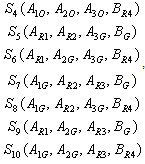
2. Model Formulation
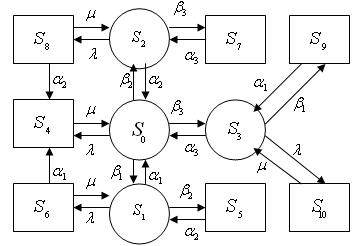 | Figure 1. schematic diagram of the System |
2.1. Mean Time to System Failure for System
Let  be the probability row vector at time
be the probability row vector at time  , then the initial conditions for this problem are as follows:
, then the initial conditions for this problem are as follows: we obtain the following system of differential equations from Figure 1 above:
we obtain the following system of differential equations from Figure 1 above: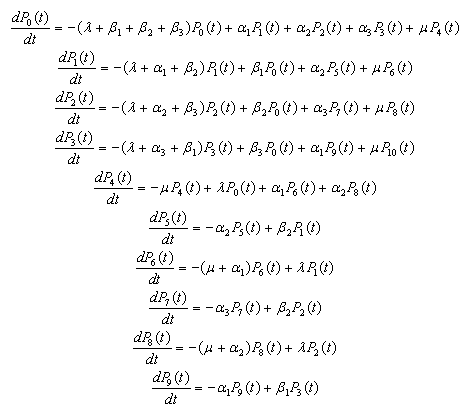
 | (1) |
The differential equations above can be put in matrix form as  where
where It is difficult to evaluate the transient solutions hence following El-Said[10], Haggag[11], El-Said and Shrbeny[12], and Wang et al[14], we delete the rows and columns of absorbing state of matrix
It is difficult to evaluate the transient solutions hence following El-Said[10], Haggag[11], El-Said and Shrbeny[12], and Wang et al[14], we delete the rows and columns of absorbing state of matrix  and take the transpose to produce a new matrix, say
and take the transpose to produce a new matrix, say . The expected time to reach an absorbing state is obtained from
. The expected time to reach an absorbing state is obtained from  Where
Where  This method is successful of the following relations:
This method is successful of the following relations: Expression for MTSF can therefore be obtain from
Expression for MTSF can therefore be obtain from | (2) |
Where 
2.2. Steady state availability Analysis for System
For the availability case of Figure 1 following El-Said[10], Haggag[11], El-Said and Shrbeny[12], and Wang et al[14], the initial conditions for this system are: The system of differential equations in for System 1 above can be expressed as:
The system of differential equations in for System 1 above can be expressed as:
 The steady-state availability is given by
The steady-state availability is given by | (3) |
In the steady state, the derivatives of the state probabilities become zero so that | (4) |
which in matrix form Using the following normalizing condition
Using the following normalizing condition | (5) |
We substitute (5) in any of the redundant rows in (4) to give  We solve for the system of equations in the matrix above to obtain the steady-state probabilities
We solve for the system of equations in the matrix above to obtain the steady-state probabilities  Where
Where 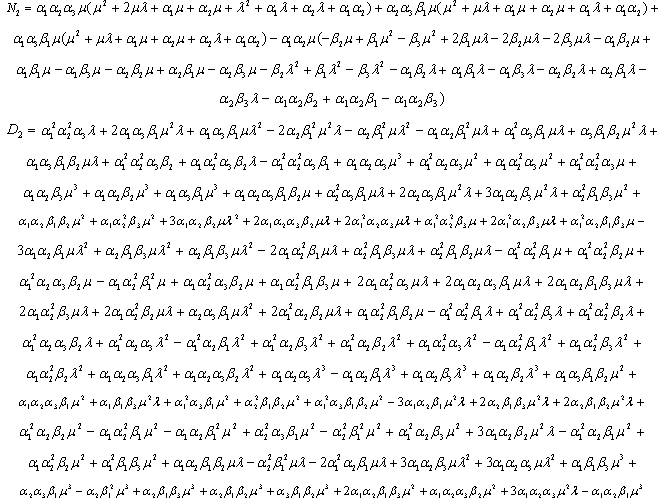
2.3. Busy Period Analysis
Using the same initial conditions as for the reliability case: The differential equations can be expressed as
The differential equations can be expressed as
 In the steady state, the derivatives of the state probabilities become zero this will enable us to compute steady state busy :
In the steady state, the derivatives of the state probabilities become zero this will enable us to compute steady state busy : | (6) |
 We solve for
We solve for  Using the following normalizing condition
Using the following normalizing condition We substitute (5) in any of the redundant rows in (4) to give
We substitute (5) in any of the redundant rows in (4) to give  The steady state busy period
The steady state busy period  is therefore
is therefore
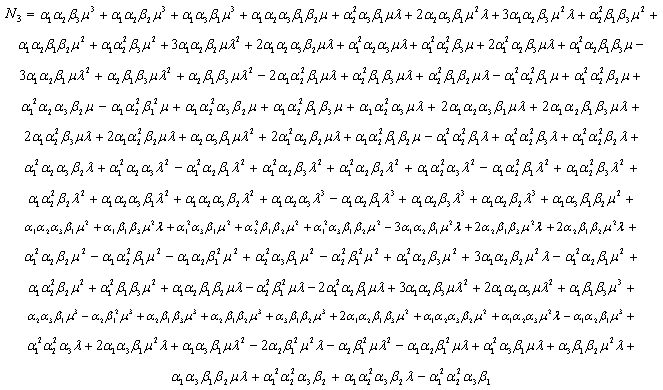
2.4. Profit Analysis
Following El-Said[10], Haggag[11], El-said and sherbeny[13] and Wang et al[14], the expected profit per unit time incurred to the system in the steady-state is given by:Profit =total revenue generated from system using - total cost due to repair of failed unit or subsystem B | (7) |
Where  : is the profit incurred to the system
: is the profit incurred to the system : is the revenue per unit up time of the system
: is the revenue per unit up time of the system : is the cost per unit time which the system is under repair
: is the cost per unit time which the system is under repair
3. Results
The following particular cases are considered: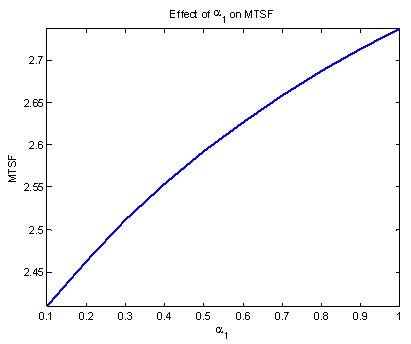 | Figure 2. effect of  on Profit on Profit |
 | Figure 3. effect of  on MTSF on MTSF |
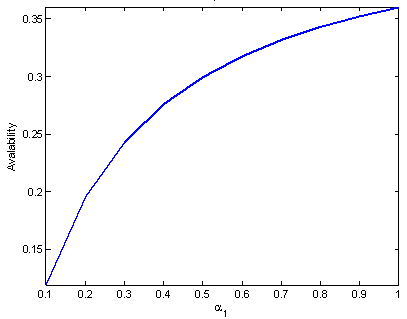 | Figure 4. effect of  on system availability on system availability |
 | Figure 5. effect of  on system availability on system availability |
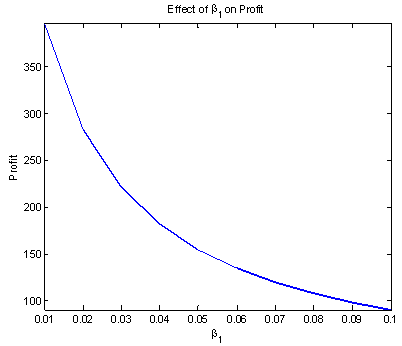 | Figure 6. effect of  on Profit on Profit |
 | Figure 7. effect of  on MTSF on MTSF |
 | Figure 8. effect of  on system availability on system availability |
 | Figure 9. effect of  on MTSF on MTSF |
 | Figure 10. effect of  on Profit on Profit |
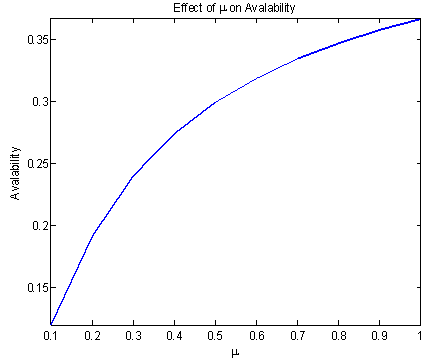 | Figure 11. effect of  on system availability on system availability |
 | Figure 12. effect of  on MTSF on MTSF |
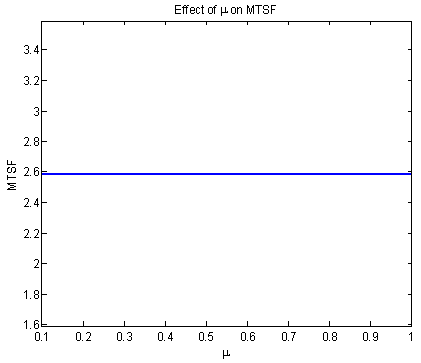 | Figure 13. effect of  on Profit on Profit |
4. Discussion
Case I: 
 and vary
and vary  for Figure 2 to 4.Case II:
for Figure 2 to 4.Case II:  ,
,  ,
,  and vary
and vary  for Figure 5 to 7.Case III:
for Figure 5 to 7.Case III:  ,
,  ,
,  , and vary
, and vary  for Figure 8 to 10.Case IV:
for Figure 8 to 10.Case IV: ,
,  ,
,  and vary
and vary  for Figure 11 to 13.Figure 2 to 4 provides description of profit function, MTSF and system availability with respect to
for Figure 11 to 13.Figure 2 to 4 provides description of profit function, MTSF and system availability with respect to  . From these figures, it is clear that both profit function, MTSF and system availability increase as
. From these figures, it is clear that both profit function, MTSF and system availability increase as  increases. In Figure 5 to 7, the behavior of system availability, profit function and MTSF are shown with respect to
increases. In Figure 5 to 7, the behavior of system availability, profit function and MTSF are shown with respect to . It is observed that system availability decrease as
. It is observed that system availability decrease as  increases. In Figure 8 to 10, the behavior of system availability, MTSF and profit function with respect to
increases. In Figure 8 to 10, the behavior of system availability, MTSF and profit function with respect to . The results in these figures have shown that system availability, MTSF and profit function decrease as
. The results in these figures have shown that system availability, MTSF and profit function decrease as  increases. Figure 11 to 13 provides description of system availability, MTSF and profit function with respect to
increases. Figure 11 to 13 provides description of system availability, MTSF and profit function with respect to . System availability and profit in Figure 11 and 13 increase with increase in
. System availability and profit in Figure 11 and 13 increase with increase in  while MTSF in Figure 12 is constant with respect to
while MTSF in Figure 12 is constant with respect to .
.
5. Conclusions
In this paper, we developed the explicit expressions for the mean time to system failure (MTSF), system availability, busy period and profit function for the system and performed graphical study to see the behavior of failure rates and repair rates parameters on system performance. It is observed that from graphical study system performance increase with repair rates and decrease with failure rates.
References
| [1] | Bhardwj, R.K. and Chander, S. (2007). Reliability and cost benefit analysis of 2-out-of-3 redundant system with general distribution of repair and waiting time. DIAS- Technology review- An Int. J. of business and IT. 4(1), 28-35 |
| [2] | Chander, S. and Bhardwaj, R.K. (2009). Reliability and economic analysis of 2-out-of-3 redundant system with priority to repair. African J. of Maths and comp. sci, 2(11), 230-236. |
| [3] | Bhardwj,R.K., and S.C. Malik. (2010). MTSF and Cost effectiveness of 2-out-of-3 cold standby system with probability of repair and inspection. Int. J. of Eng. Sci. and Tech. 2(1), 5882-5889 |
| [4] | Taneja, G., A. Goyal and D.V. Singh (2011). Reliability and Cost benefit analysis of a system comprising one big unit and two small identical units with priority for operation/repair to big unit. Mathematical Sciences, Vol. 5 No. 3, 235-248 |
| [5] | Malik, S.C., Bharwaj, R.K. and Grewal, A.S. (2010). Probabilistic analysis of a system of two non identical parallel units with priority to repair to repair subject to inspection. Journal of reliability and statistical studies, vol. 3(1), pp 1-11 |
| [6] | Mahmoud, M.A.W. and Moshref, M.E. (2010). On a two unit cold standby system considering hardware, human error failures and preventive maintenance, Mathematics and Computer modeling, 51(5-6), pp 736-745. |
| [7] | Yusuf, I. and Bala, S.I. (2012). Stochastic modeling of a two unit parallel system under two types of failures. International Journal of Latest trends in Mathematics, Vol. 2 (1), pp 44-53 |
| [8] | Kumar, J. and Kadyan, M.S. (2012). Profit analysis of a system of non identical units with degradation and replacement. International journal of computer application, vol. 40 (3), pp 19-25 |
| [9] | Sureria, J.K., Malik, S.C. and Anand, J. (2012). Cost benefit analysis of a computer system with priority to software replacement over hardware repair. Applied Mathematical Sciences, vol. 6 (75), pp 3723-3734. |
| [10] | El-Said, K.M.,. ( 2008).Cost analysis of a system with preventive maintenance by using Kolmogorov’s forward equations method. Ame. J. of App. Sci. 5(4), 405-410 |
| [11] | Haggag, M.Y., (2009). Cost analysis of a system involving common cause failures and preventive maintenance.J. Maths. And Stat. 5(4), 305-310 |
| [12] | El-Said, K.M., and M.S. El-Sherbeny. ( 2005).Profit analysis of a two unit cold standby system with preventive maintenance and random change in units. J. Maths and Stat.,1 (1) 71-77 |
| [13] | El-Said, K.M., and M.S. El-Sherbeny. (2005) .Evaluation of reliability and availability characteristics of two different systems by using linear first order differential equations. J. Maths and Stat.,1 (2) 119-123 |
| [14] | Wang, K., Hseih, C., and Liou, C. H. (2006). Cost benefit analysis of series systems with cold standby components and a repairable service station. Quality technology and quantitative management. Vol. 3(1), pp 77-92. |
| [15] | Bhardwaj., R.K., and S.C. Malik (2010). MTSF and cost effectiveness of 2-out-of-3 cold standby system with probability of repair and inspection. International Journal of engineering, science and technology, vol. 2(10), 5882-5889 |

 Unit
Unit  in subsystem A is operational
in subsystem A is operational 
 Failed unit in subsystem
Failed unit in subsystem  under type
under type  repair
repair Unit
Unit  in subsystem
in subsystem  is good
is good Subsystem
Subsystem  is operational
is operational Subsystem
Subsystem  is failed and under type 4 repair
is failed and under type 4 repair Type
Type  failure rate of unit
failure rate of unit  in subsystem A
in subsystem A Type
Type  repair rate of unit
repair rate of unit  in subsystem A
in subsystem A Failure rate of subsystem B
Failure rate of subsystem B Repair rate of subsystem B
Repair rate of subsystem B Failed states:
Failed states:
 be the probability row vector at time
be the probability row vector at time  , then the initial conditions for this problem are as follows:
, then the initial conditions for this problem are as follows: we obtain the following system of differential equations from Figure 1 above:
we obtain the following system of differential equations from Figure 1 above:

 where
where It is difficult to evaluate the transient solutions hence following El-Said[10], Haggag[11], El-Said and Shrbeny[12], and Wang et al[14], we delete the rows and columns of absorbing state of matrix
It is difficult to evaluate the transient solutions hence following El-Said[10], Haggag[11], El-Said and Shrbeny[12], and Wang et al[14], we delete the rows and columns of absorbing state of matrix  and take the transpose to produce a new matrix, say
and take the transpose to produce a new matrix, say . The expected time to reach an absorbing state is obtained from
. The expected time to reach an absorbing state is obtained from  Where
Where  This method is successful of the following relations:
This method is successful of the following relations: Expression for MTSF can therefore be obtain from
Expression for MTSF can therefore be obtain from

 The system of differential equations in for System 1 above can be expressed as:
The system of differential equations in for System 1 above can be expressed as:
 The steady-state availability is given by
The steady-state availability is given by

 Using the following normalizing condition
Using the following normalizing condition
 We solve for the system of equations in the matrix above to obtain the steady-state probabilities
We solve for the system of equations in the matrix above to obtain the steady-state probabilities  Where
Where 
 The differential equations can be expressed as
The differential equations can be expressed as
 In the steady state, the derivatives of the state probabilities become zero this will enable us to compute steady state busy :
In the steady state, the derivatives of the state probabilities become zero this will enable us to compute steady state busy :
 We solve for
We solve for  Using the following normalizing condition
Using the following normalizing condition We substitute (5) in any of the redundant rows in (4) to give
We substitute (5) in any of the redundant rows in (4) to give  The steady state busy period
The steady state busy period  is therefore
is therefore


 : is the profit incurred to the system
: is the profit incurred to the system : is the revenue per unit up time of the system
: is the revenue per unit up time of the system : is the cost per unit time which the system is under repair
: is the cost per unit time which the system is under repair
 on Profit
on Profit
 on MTSF
on MTSF
 on system availability
on system availability
 on system availability
on system availability
 on Profit
on Profit
 on MTSF
on MTSF
 on system availability
on system availability
 on MTSF
on MTSF
 on Profit
on Profit
 on system availability
on system availability
 on MTSF
on MTSF
 on Profit
on Profit
 and vary
and vary  for Figure 2 to 4.Case II:
for Figure 2 to 4.Case II:  ,
,  ,
,  and vary
and vary  for Figure 5 to 7.Case III:
for Figure 5 to 7.Case III:  ,
,  ,
,  , and vary
, and vary  for Figure 8 to 10.Case IV:
for Figure 8 to 10.Case IV: ,
,  ,
,  and vary
and vary  for Figure 11 to 13.Figure 2 to 4 provides description of profit function, MTSF and system availability with respect to
for Figure 11 to 13.Figure 2 to 4 provides description of profit function, MTSF and system availability with respect to  . From these figures, it is clear that both profit function, MTSF and system availability increase as
. From these figures, it is clear that both profit function, MTSF and system availability increase as  increases. In Figure 5 to 7, the behavior of system availability, profit function and MTSF are shown with respect to
increases. In Figure 5 to 7, the behavior of system availability, profit function and MTSF are shown with respect to . It is observed that system availability decrease as
. It is observed that system availability decrease as  increases. In Figure 8 to 10, the behavior of system availability, MTSF and profit function with respect to
increases. In Figure 8 to 10, the behavior of system availability, MTSF and profit function with respect to . The results in these figures have shown that system availability, MTSF and profit function decrease as
. The results in these figures have shown that system availability, MTSF and profit function decrease as  increases. Figure 11 to 13 provides description of system availability, MTSF and profit function with respect to
increases. Figure 11 to 13 provides description of system availability, MTSF and profit function with respect to . System availability and profit in Figure 11 and 13 increase with increase in
. System availability and profit in Figure 11 and 13 increase with increase in  while MTSF in Figure 12 is constant with respect to
while MTSF in Figure 12 is constant with respect to .
.  Abstract
Abstract Reference
Reference Full-Text PDF
Full-Text PDF Full-text HTML
Full-text HTML